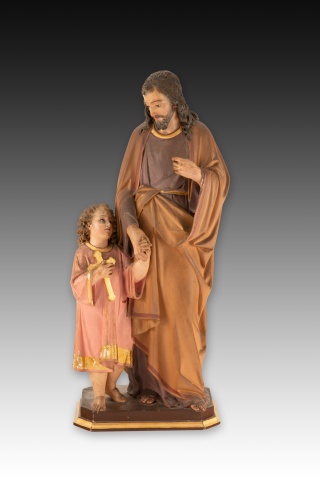Results 49 to 58 of 58
«« « 123 » »»
-
Virgin of Dressing. Carved and polychrome wood, etc. Spanish school, 17th century; later clothing. It has damage. Polychrome wooden carving of the dressing or dressing room type that has a series of garments: skirt, blouse, rostrillo, etc. Religious dressing sculptures were very common during the Spanish Baroque (and later), and there may be cases of works in which the unseen part was barely rough-cut and others in which the entire thing is carved, with many intermediate points.
· Size: 26x26x57 cms.
ANTIQUES
SCULPTURE
Ref.: ZF1183
-
“Ramón Aranaz”. Bust in bronze. Antonio Yerro Feltrer (Valencia, 1842-1911). Signed. Founder “V. Ríos”. Bust of Ramón Aranaz (Valencia 1831-Madrid 1898), businessman, banker and Valencian politician, dressed in a suit and with a ribbon across his chest. The sculptor, Antonio Yerro, studied at the Academy of Fine Arts of San Carlos in Valencia, and won various prizes at exhibitions such as the National Fine Arts Exhibition of 1884 and was awarded several decorations in recognition of his artistic merits.
· Size: 27x22x39 cms.
ANTIQUES
SCULPTURE
Ref.: Z3707
-
Base. Carved and polychrome wood. Spanish school, 17th century. Rectangular base, made of carved and polychrome wood in grey tones, which has been decorated with a series of mouldings and toruses, some smooth and others enhanced with a fine relief of plant elements and garlands with a clear classicist influence. The piece is finished off with a spike to secure the sculpture that is placed on it. Weight: 6.4 kg.
· Size: 37x25x44 cms , altura base 23 cms
ANTIQUES
SCULPTURE
Ref.: ZE346
-
Peace-bearer. Bronze. 16th century. Bronze peace-bearer with an S-shaped handle on the back made of the same material and a decoration in light relief on the front showing, beneath an architectural composition with a clear classicist influence (a semicircular arch with a scallop shell inside and scrolls outside, two pillars with vegetal decoration and a base with heraldry), the Virgin Mary with the Child, accompanied by two angels and placed on a pedestal on which a legend can be seen (AVEREGINA/CELOUM?, in allusion to the Marian antiphon Ave Regina Caelorum, typical of the time of Lent).
· Size: 6.5x3x11 cms
ANTIQUES
SCULPTURE
Ref.: ZF0866
-
Niche. Gilded and polychrome pine wood. Spain, 17th century. A niche made of carved and gilded pine wood, decorated with mouldings, a scallop shape and plant elements on the upper part, which shows a clear classicist influence, common in some Spanish Baroque schools of the 17th century. This type of piece usually formed part of an altarpiece, and was normally used to house sculptures.
· Size: 47x14x66 cms
ANTIQUES
SCULPTURE
Ref.: ZF0954
-
Sold

Saint Joseph with the Child Jesus. Polychrome wood. Spanish School, 19th century. Polychrome sculpture depicting Saint Joseph dressed in a tunic and cloak, standing, holding the Child Jesus by the hand, who appears wearing a short tunic and holding a Latin cross to his chest, following the iconography and composition common in the Spanish school of the 19th and 20th centuries (compare with examples from Olot, etc.).
· Size: 25x16x56 cms.
ANTIQUES
SCULPTURE
Ref.: ZF1400
-
Niche. Carved and polychrome wood. 16th century. Wall niche with a rectangular frontal recess topped by a gilded, veneered shape with two polychrome angel heads in the corners, and a dark polychrome space with gilded Classicist elements (candlesticks with grotesques, latticework, scrolls, etc.). The base features a polygonal finish on the front, with a red edge, like the rest of the piece. This type of pedestal was very common in private oratories in both civil (homes, etc.) and religious (convents, chapels, etc.) settings, for placing and highlighting small sculptures. Weight: 850 grams.
· Size: 18x9x47 cms.
ANTIQUES
SCULPTURE
Ref.: ZF1204
-

Devotional medal of Saint Nicholas on a support. Gilt bronze, textile, metal. 18th century. Devotional medal in gilded bronze placed on a support with wires that presents an oval frame enhanced with a crest with vegetal elements in a symmetrical composition and another top below also with vegetal elements and scrolls, and the figure of a saint inside this smooth frame. Standing, holding a staff in one hand and raising the other in a gesture of blessing, is a male figure dressed in liturgical attire, accompanied by some small figures praying, placed in a barrel or bucket. Saint Nicholas of Myra or Bari was a bishop who died around the middle of the 4th century AD. One of his most famous miracles was that of resurrecting three children (shown in this work) sacrificed by an innkeeper to feed his clients. Although he was bishop of the city of Myra, he is shown here wearing liturgical vestments but without the usual headdress (mitre). The three spheres that appear on the book would allude to the miracle in which the saint helps the father of three girls to gather a dowry for them (as they are three golden spheres).
· Size: 9x11,5x1 cms.
ANTIQUES
SCULPTURE
Ref.: ZF0460
-
Horse. Patinated metal. 19th century. Figure of a walking horse with a bronze base and a patinated iron animal. It shows a strong influence from the animal figures common in the 19th-century French school, such as the care taken in the composition, the search for naturalism, etc. It is particularly reminiscent of models by Pierre-Jules Mène (Paris, 1810-1879), a French sculptor specializing in domestic animals, whose work is held in important private collections and institutions such as the Louvre Museum. Weight: 11 kg.
· Size: 4013x30 cms.
ANTIQUES
SCULPTURE
Ref.: ZF1461
-
Box with landscape. Red lacquer. Possibly China, 20th century. Low cylindrical box with a flat lid, red on the outside and black on the inside, decorated on the lid and the upper part of the body with bands of geometric and vegetal frets and a landscape and garden scene with pavilions and small-sized figures of the type common on these visas in the Far East.
· Size: 32x32x13.5
ANTIQUES
SCULPTURE
Ref.: ZF0922